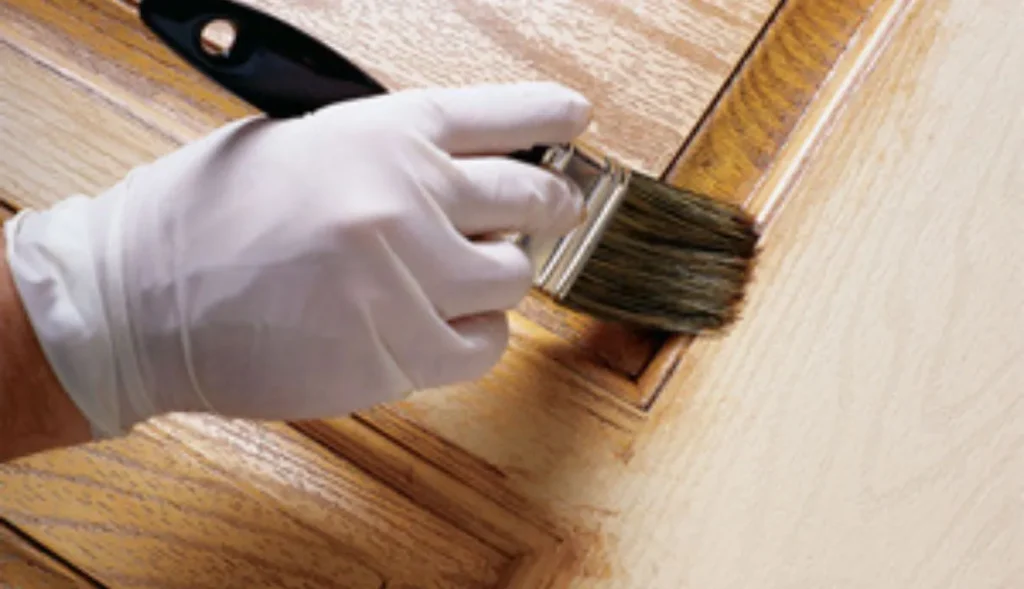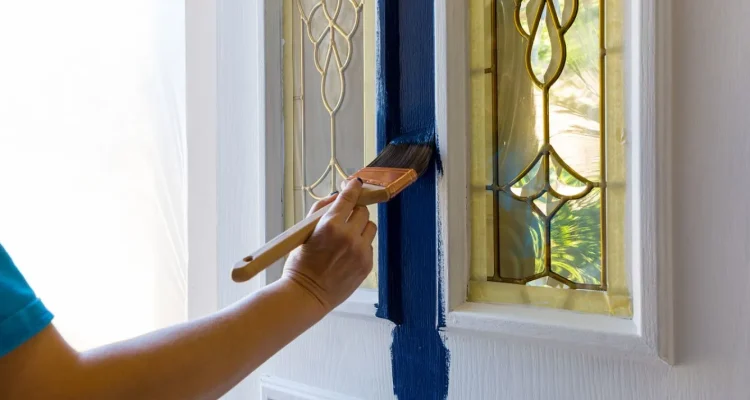How to Paint Fiberglass Doors
Painting a fiberglass door can seem like a daunting task, but with the right guidance and tools, you can achieve a professional-looking finish that enhances your home’s curb appeal. Whether you’re giving an old door a fresh look or customizing a new one, following the correct steps ensures long-lasting and beautiful results.

Understanding Fiberglass Doors
What Are Fiberglass Doors?
Fiberglass doors are made from reinforced glass fibers embedded in a resin matrix, making them durable and resistant to weather, warping, and rotting. Unlike wood, fiberglass doesn’t swell or shrink, and it offers better insulation, making it an excellent choice for exterior doors.
Benefits of Fiberglass Over Wood and Metal
Fiberglass doors provide the aesthetic appeal of wood without the maintenance hassles. They are more energy-efficient, resistant to dents and scratches, and can be painted or stained to match any home style. Unlike metal doors, fiberglass doesn’t rust, making it ideal for all climates.
Choosing the Right Paint for Fiberglass
Types of Paint Suitable for Fiberglass
When painting fiberglass doors, choosing the right paint is crucial. Look for exterior-grade acrylic latex paint or an acrylic urethane blend. These paints provide flexibility and durability, adhering well to fiberglass surfaces without cracking or peeling.
Importance of Primer
A primer specifically designed for fiberglass is essential. It not only helps the paint adhere better but also provides a smooth surface for the paint to lay on, ensuring an even finish. Without primer, the paint may not stick properly, leading to an uneven appearance and potential peeling.
Color Options and Finishes
Fiberglass doors can be painted in a wide range of colors and finishes. Whether you prefer a classic wood-look stain, a bold solid color, or a sleek satin finish, the options are endless. Just ensure the paint you choose is suitable for exterior use to withstand the elements.
Gathering Your Materials
Tools and Supplies You’ll Need
Before you start, gather all the necessary materials:
- Exterior-grade acrylic latex paint
- Fiberglass primer
- Fine-grit sandpaper
- Painter’s tape
- Paintbrushes, rollers, or spray gun
- Drop cloths
- Screwdrivers (for removing hardware)
- Safety gear (gloves, mask, goggles)
Safety Gear to Consider
Painting can expose you to fumes and dust, so wearing safety gear like gloves, a mask, and goggles is important. Ensure your workspace is well-ventilated to minimize inhalation of harmful substances.
Preparing the Fiberglass Door for Painting
Cleaning the Surface Thoroughly
A clean surface is vital for good paint adhesion. Start by washing the door with a mild detergent and water to remove dirt, grease, and grime. Rinse thoroughly and allow it to dry completely before moving on to the next step.
Sanding the Door: Why and How
Lightly sanding the door with fine-grit sandpaper helps the primer and paint adhere better. Sanding also smooths out any imperfections, giving you a better final finish. Be gentle to avoid damaging the fiberglass surface.
Applying Painter’s Tape and Protecting Hardware
Protect any areas you don’t want to paint, such as the glass inserts or hardware, by covering them with painter’s tape. Remove the door hardware if possible to avoid getting paint on it. Use drop cloths to protect the surrounding area from drips and splatters.
Priming the Fiberglass Door
Why Priming is Crucial
Primer acts as a bonding agent between the door and the paint, ensuring better adhesion and longevity. Skipping this step can result in a finish that peels or chips easily, especially in areas exposed to weather.
Step-by-Step Guide to Priming
- Stir the primer thoroughly to ensure it’s well-mixed.
- Apply a thin, even coat using a brush, roller, or spray gun.
- Work in small sections, covering the entire surface without leaving drips or thick spots.
- Allow the primer to dry completely according to the manufacturer’s instructions, typically 4-6 hours.
Allowing Proper Drying Time
Rushing the process can lead to a poor finish. Make sure the primer is completely dry before applying paint. This step is crucial for preventing bubbles, peeling, or an uneven paint job.
Painting the Fiberglass Door
Techniques for Applying Paint Evenly
When it’s time to paint, using the right technique is key. Whether you’re using a brush, roller, or spray gun, apply the paint in thin, even coats. Start from the top of the door and work your way down, maintaining a wet edge to prevent lap marks.
Using a Brush vs. a Roller
Brushes are great for detailed work around edges and panels, while rollers cover large, flat areas quickly and smoothly. A combination of both may give you the best results. For a smooth finish, choose high-quality brushes and rollers designed for smooth surfaces.
Tips for Achieving a Smooth Finish
To avoid brush marks or roller texture, apply the paint with light pressure and keep the strokes consistent. Sanding lightly between coats with fine-grit sandpaper can also help achieve a flawless finish.
Applying Multiple Coats
Why More Than One Coat is Necessary
One coat of paint is rarely enough to cover a fiberglass door evenly, especially if you’re making a dramatic color change. Applying multiple coats ensures full coverage and a vibrant, long-lasting color.
Drying Time Between Coats
Allow each coat to dry completely before applying the next. Typically, this takes 4-6 hours, but check your paint’s specific instructions. Rushing can lead to uneven color or texture issues.
How to Sand Between Coats for Best Results
Lightly sand the door between coats to remove any imperfections and ensure a smooth surface for the next layer of paint. Wipe away dust with a clean, dry cloth before applying the next coat.
Sealing and Protecting the Paint Job
The Importance of a Top Coat
A top coat or sealant protects your paint job from the elements, including UV rays, moisture, and temperature changes. It also adds a subtle sheen that enhances the door’s appearance.
Types of Sealants for Fiberglass Doors
Choose a clear, UV-resistant sealant designed for exterior use. A satin or semi-gloss finish is often preferred for its durability and easy maintenance. Apply the sealant in thin, even layers, following the manufacturer’s instructions.
Application Tips for Long-Lasting Protection
Just like with the paint, applying the sealant in thin coats is crucial for a smooth, even finish. Make sure to cover the entire door, paying extra attention to edges and corners where moisture can seep in.
Drying and Curing the Painted Door
Proper Drying Conditions
After applying the final coat of paint and sealant, allow the door to dry in a dust-free, well-ventilated area. Ideal conditions include moderate temperatures and low humidity to prevent the paint from drying too quickly or unevenly.
How Long to Wait Before Reinstalling the Door
Even if the door feels dry to the touch, it may not be fully cured. Wait at least 24-48 hours before reinstalling the door to avoid smudging or damaging the fresh paint job.
Reinstalling the Door and Final Touches
Removing Painter’s Tape and Reattaching Hardware
Carefully remove the painter’s tape, pulling it away from the painted surface to avoid peeling. Reattach any hardware, being cautious not to scratch the new paint. Inspect the door for any areas that may need touch-ups.
Inspecting for Touch-Ups
Before calling the job done, inspect the door under different lighting conditions to spot any missed areas or imperfections. Touch them up with a small brush and allow the paint to dry completely.
Polishing the Final Finish
If desired, you can polish the door’s surface with a soft cloth once it’s fully cured. This adds a subtle shine and helps protect the finish.
Maintenance Tips for Painted Fiberglass Doors
Cleaning and Caring for the Painted Surface
To keep your painted fiberglass door looking its best, clean it regularly with a mild detergent and water. Avoid abrasive cleaners or scrubbing tools that could damage the paint.
How to Handle Chips and Scratches
If your door gets chipped or scratched, touch it up with the original paint. Lightly sand the area, clean it, and apply a small amount of paint with a fine brush.
Common Mistakes to Avoid
Skipping the Primer
Never skip the primer! It’s essential for ensuring the paint adheres properly and lasts longer. Without primer, you risk peeling, chipping, and uneven color.
Using the Wrong Type of Paint
Not all paints are suitable for fiberglass. Make sure to use exterior-grade acrylic latex or acrylic urethane paint specifically designed for fiberglass to avoid peeling and cracking.
Not Allowing Proper Drying Time
Rushing the drying process can ruin your hard work. Be patient and allow each coat to dry completely before moving on to the next step.
DIY vs. Professional Help
When to Tackle the Job Yourself
Painting a fiberglass door is a manageable DIY project if you have the time, patience, and the right tools. It can be a rewarding experience that saves you money and lets you customize your home’s appearance.
Situations Where Hiring a Professional is Best
If you’re unsure about your painting skills or if the door has intricate details that require special attention, hiring a professional may be worth the investment. Professionals have the experience and tools to ensure a flawless finish.
FAQs
How Long Does It Take to Paint a Fiberglass Door?
Painting a fiberglass door can take anywhere from 2-3 days, depending on drying times between coats and the complexity of the job.
Can I Paint Over an Already Painted Fiberglass Door?
Yes, you can paint over an already painted fiberglass door. Just be sure to clean, sand, and prime the surface properly before applying the new paint.
Do I Need to Remove the Door to Paint It?
While it’s not absolutely necessary, removing the door makes the job easier and helps avoid drips or uneven coverage.
How Can I Avoid Brush Marks When Painting?
To avoid brush marks, use high-quality brushes, apply thin coats of paint, and sand lightly between coats for a smooth finish.
What is the Best Way to Maintain a Painted Fiberglass Door?
Regular cleaning with a mild detergent and prompt touch-ups for any chips or scratches will help maintain the appearance and durability of your painted fiberglass door.

Conclusion
Painting a fiberglass door is a fantastic way to refresh your home’s appearance and increase its value. By following these steps, you can achieve a smooth, durable finish that will stand the test of time. Whether you’re a seasoned DIYer or a beginner, taking the time to prepare and paint your door properly will result in a job you can be proud of.


Congratulation!